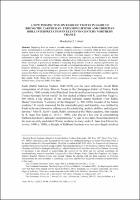Please use this identifier to cite or link to this item:
https://hdl.handle.net/20.500.12202/6136Full metadata record
| DC Field | Value | Language |
|---|---|---|
| dc.contributor.author | Cohen, Mordechai Z. | - |
| dc.date.accessioned | 2020-09-21T16:39:12Z | - |
| dc.date.available | 2020-09-21T16:39:12Z | - |
| dc.date.issued | 2017 | - |
| dc.identifier.citation | Cohen, Mordechai Z. “A New Perspective on Rashi of Troyes in Light of Bruno the Carthusian: Exploring Jewish and Christian Bible interpretation in eleventh-century Northern France,” Viator 48,1 (2017): 39–86. | en_US |
| dc.identifier.issn | Print ISSN: 0083-5897 Online ISSN: 2031-0234. | - |
| dc.identifier.uri | https://www.brepolsonline.net/doi/pdf/10.1484/J.VIATOR.5.115316 | en_US |
| dc.identifier.uri | https://hdl.handle.net/20.500.12202/6136 | - |
| dc.description | Scholarly article/ Open access | en_US |
| dc.description.abstract | Departing from the norm in eleventh-century Ashkenazic learning, Rashi advanced peshat (plain sense) interpretation as a yardstick to evaluate midrashic readings of scripture. While he drew upon Jewish sources such as the ancient Aramaic Targums and the lexicographic works of the tenth-century Andalusian linguists Menahem ben Saruq and Dunash Ibn Labrat, important aspects of Rashi’s exegesis are best understood in light of contemporaneous Christian interpretation, especially as manifested in the Psalms commentary of Bruno, master at the Rheims cathedral school. Following the model of Remigius of Auxerre, Bruno developed a grammatical method of analyzing King David’s words as classical grammarians had glossed Virgil, a standard by which Bruno critically selected patristic interpretations that best reflect David’s prophetic intentions, which he naturally assumed to be Christological. Rashi developed similar analytic criteria, perhaps through his training as a glossator of the Talmud in the Rhineland rabbinic academies. It is conceivable that he was aware of Bruno’s grammatically sophisticated method and that this could have spurred Rashi to devise an analogous one to bolster a traditional Jewish understanding of scripture. | en_US |
| dc.language.iso | en_US | en_US |
| dc.publisher | Berkeley, CA : University of California Press, 1970- Turnhout, Belgium : Brepols Publishers | en_US |
| dc.relation.ispartofseries | Viator;48(1) | - |
| dc.rights | Attribution-NonCommercial-NoDerivs 3.0 United States | * |
| dc.rights.uri | http://creativecommons.org/licenses/by-nc-nd/3.0/us/ | * |
| dc.subject | Rashi | en_US |
| dc.subject | Bruno the Carthusian | en_US |
| dc.subject | Jewish-Christian bible interpretation | en_US |
| dc.subject | 11th-century northern France | en_US |
| dc.title | A New Perspective on Rashi of Troyes in Light of Bruno the Carthusian: Exploring Jewish and Christian Bible interpretation in eleventh-century Northern France. | en_US |
| dc.type | Article | en_US |
| dc.contributor.orcid | https://orcid.org/0000-0003-1621-6116 | |
| local.yu.facultypage | https://www.yu.edu/faculty/pages/cohen-mordechai | |
| Appears in Collections: | Bernard Revel Graduate School of Jewish Studies (BRGS): Faculty Publications | |
Files in This Item:
| File | Description | Size | Format | |
|---|---|---|---|---|
| CohenM New Perspective j.viator.5.115316.pdf | 944.33 kB | Adobe PDF |  View/Open |
This item is licensed under a Creative Commons License

